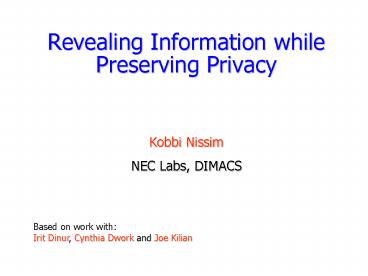Revealing Information while Preserving Privacy PowerPoint PPT Presentation
Title: Revealing Information while Preserving Privacy
1
Revealing Information while Preserving Privacy
- Kobbi Nissim
- NEC Labs, DIMACS
Based on work with Irit Dinur, Cynthia Dwork
and Joe Kilian
2
The Hospital Story
3
Easy Tempting Solution
A Bad Solution
Idea a. Remove identifying information (name,
SSN, )
b. Publish data
- Observation harmless attributes uniquely
identify many patients (gender, approx age,
approx weight, ethnicity, marital status) - Worserare attribute (CF ? 1/3000)
4
Our Model Statistical Database (SDB)
5
The Privacy Game Information-Privacy Tradeoff
- Private functions
- want to hide ?i(d1, ,dn)di
- Information functions
- want to reveal fq(d1, ,dn)?i?q di
- Explicit definition of private functions
6
Approaches to SDB Privacy AW 89
- Query Restriction
- Require queries to obey some structure
- Perturbation
- Give noisy or approximate answers
This talk
7
Perturbation
- Database d d1,,dn
- Query q ? n
- Exact answer aq ?i?qdi
- Perturbed answer âq
- Perturbation E For all q âq aq E
- General Perturbation Prq âq aq E
1-neg(n) - 99, 51
8
Perturbation Techniques AW89
- Data perturbation
- Swapping Reiss 84Liew, Choi, Liew 85
- Fixed perturbations Traub, Yemini, Wozniakowski
84 Agrawal, Srikant 00 Agrawal, Aggarwal 01 - Additive perturbation didiEi
- Output perturbation
- Random sample queries Denning 80
- Sample drawn from query set
- Varying perturbations Beck 80
- Perturbation variance grows with number of
queries - Rounding Achugbue, Chin 79 Randomized Fellegi,
Phillips 74
9
Main Question How much perturbation is needed to
achieve privacy?
10
Privacy from ??n Perturbation
(an example of a useless database)
- Database d?R0,1n
- Can we do better?
- Smaller E ?
- Usability ???
- Privacy is preserved
- If E ? ?n (lgn)2, whp always use rule 3
- No information about d is given!
- No usability!
11
Defining Privacy
(not) Defining Privacy
- Elusive definition
- Application dependent
- Partial vs. exact compromise
- Prior knowledge, how to model it?
- Other issues
12
The Useless Database Achieves Best Possible
PerturbationPerturbation ltlt ?n Implies no
Privacy!
- Main Theorem Given a DB response algorithm with
perturbation E ltlt ?n, there is a poly-time
reconstruction algorithm that outputs a database
d, s.t. dist(d,d) lt o(n).
13
The Adversary as a Decoding Algorithm
n bits
(Recall âq ?i?qdi pertq ) Decoding Problem
Given access to âq1,, âq2n reconstruct d in time
poly(n).
14
Goldreich-Levin Hardcore Bit
n bits
Where âq ?i?qdi mod 2 on 51 of the subsets The
GL Algorithm finds in time poly(n) a small list
of candidates, containing d
15
Comparing the Tasks
16
Recall Our Goal Perturbation ltlt ?n Implies no
Privacy!
- Main Theorem Given a DB response algorithm with
perturbation E lt ?n, there is a poly-time
reconstruction algorithm that outputs a database
d, s.t. dist(d,d) lt o(n).
17
Proof of Main Theorem The Adversary
Reconstruction Algorithm
- Query phase Get âqj for t random subsets
q1,,qt of n
- Weeding phase Solve the Linear Program
- 0 ? xi ? 1
- ?i?qj xi - âqj ? E
- Rounding Let ci round(xi), output c
Observation An LP solution always exists, e.g.
xd.
18
Proof of Main Theorem Correctness of the Algorithm
- Consider x(0.5,,0.5) as a solution for the LP
- Such a q disqualifies x as a solution for the LP
- We prove that if dist(x,d) gt ???n, then whp
there will - be a q among q1,,qt that disqualifies x
19
Extensions of the Main Theorem
- Imperfect perturbation
- Can approximate the original bit string even if
database answer is within perturbation only for
99 of the queries - Other information functions
- Given access to noisy majority of subsets we
can approximate the original bit-string.
20
Notes on Impossibility Results
- Exponential Adversary
- Strong breaking of privacy if E ltlt n
- Polynomial Adversary
- Non-adaptive queries
- Oblivious of perturbation method and database
distribution - Tight threshold E ? ?n
- What if adversary is more restricted?
21
Bounded Adversary Model
- Database d?R0,1n
- Theorem If the number of queries is bounded by
T, then there is a DB response algorithm with
perturbation of ?T that maintains privacy. - With a reasonable definition of privacy
22
Summary and Open Questions
- Very high perturbation is needed for privacy
- Threshold phenomenon above ?n total privacy,
below ?n none (poly-time adversary) - Rules out many currently proposed solutions for
SDB privacy - Q whats on the threshold? Usability?
- Main tool A reconstruction algorithm
- Reconstructing an n-bit string from perturbed
partial sums/thresholds - Privacy for a T-bounded adversary with a random
database - ?T perturbation
- Q other database distributions
- Q Crypto and SDB privacy?
23
Our Privacy Definition (bounded adversary model)
i
(transcript, i)
di
Fails w.p. gt ½-?
24
The Adversary as a Decoding Algorithm
partial sums
perturbed sums

